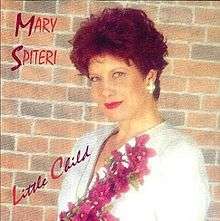Mary Spiteri

Mary Spiteri is a popular cabaret artiste from Malta. She was born on 25 October 1947 in Naxxar. In 1975, Mary Spiteri represented Malta in the Tokyo Music Festival and was awarded with the 'Outstanding Award' for her entry Go On.
Eurovision and later
Mary represented Malta in the 1992 Eurovision Song Contest held in Malmö with the song "Little Child".[1] Spiteri finished in third place behind Ireland and the United Kingdom. 1992 was not Mary's first attempt at Eurovision. In 1971, she participated in the Maltese heat of Eurovision with the song "Min Int?" (Who Are You?). Another attempt was made in 1975 when Mary performed two songs in the Maltese final, "Live For Tomorrow" and "Try a Little Love Today". Both failed.
After her 1992 appearance Mary became something of a diva figure to Eurovision fans and was presented with an award by Eurovision Network at their convention held in Coventry that year.
Mary's subsequent efforts to return to the Eurovision stage have not been successful. She was unplaced in the 1995 Maltese final with "Just One Love" but managed third place in 1997 with "Lovers Play with Words". In September 2006, Mary announced that she hoped to participate in the Malta Song for Europe Festival in 2007, and submitted a number of songs, none of which were selected for the Maltese Song for Europe Festival.
Mary tried again and she has successfully entered two songs which competed in Malta Song For Europe in 2008, but was unsuccessful in reaching the Eurovision.
In 2014 it was announced that Mary Spiteri held the longest note for 13 seconds in Eurovision Song Contest history with her performance of Little Child in 1992.[2]
| Awards and achievements | ||
|---|---|---|
| Preceded by Paul & Georgina with "Could It Be" |
Malta in the Eurovision Song Contest 1992 |
Succeeded by William Mangion with "This Time" |